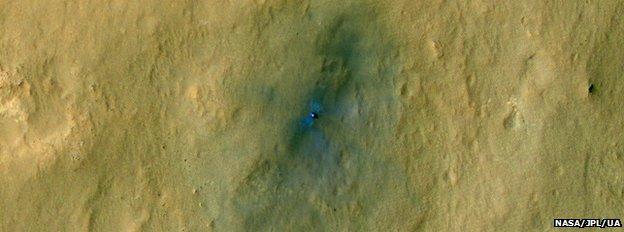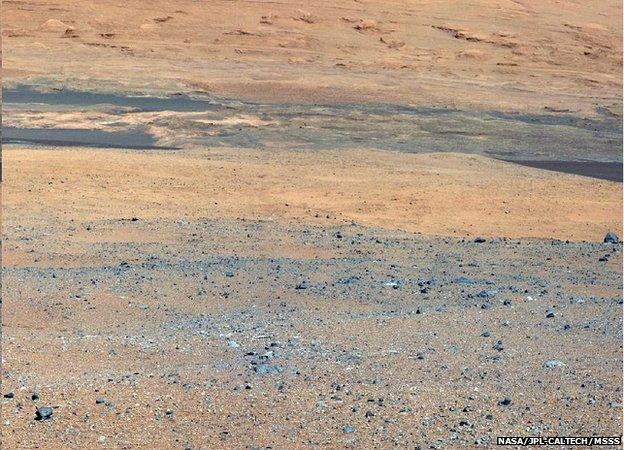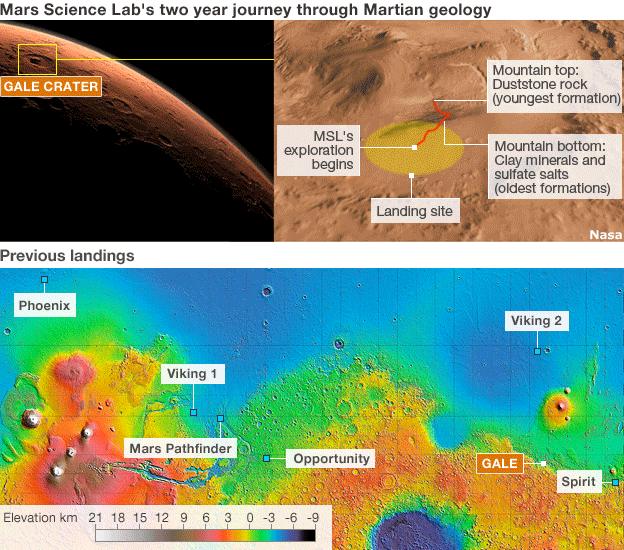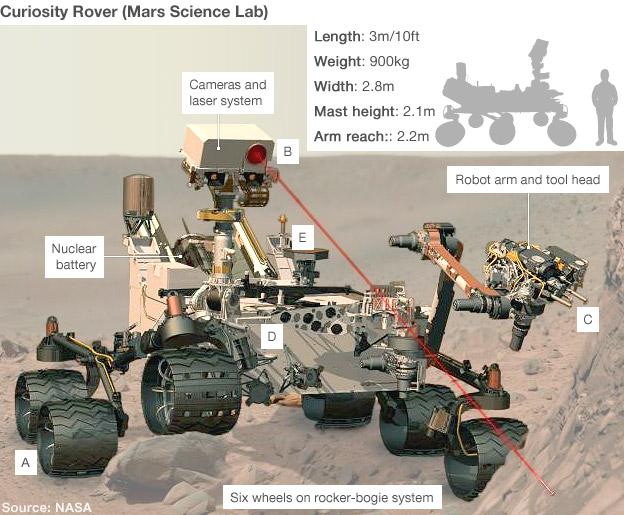Nasa's Curiosity Mars rover seen in new satellite image
- Published

The MRO image shows the terrain around the rover (double blue/white dot) at its landing site within Gale Crater on Mars. The blue fans either side are rocket blast marks in the ground
Nasa has used its high-resolution imaging satellite at the Red Planet to look down on the Curiosity rover and acquire a new picture of the recently landed six-wheeled robot.
The vehicle appears as a double dot.
The view from the Mars Reconnaissance Orbiter (MRO), external has been colour enhanced to emphasise certain ground features.
These include the disturbance in the soil made either side of the vehicle by the rocket powered crane that lowered Curiosity into Gale Crater a week ago.
"We can clearly see Curiosity - it's like two bright spots that we see, and their shadows. And then it's surrounded by the blast pattern from the descent stage - those little blue fans right next to it (false colour blue)," explained Alfred McEwen, the principal investigator on MRO's High Resolution Image Science Experiment (HiRise) camera.
Since its 6 August (GMT) touchdown, engineers have been checking out the rover's systems and instruments.
And the past four days have been spent upgrading the vehicle's onboard software.
Curiosity runs two computers - a main unit and a back-up. Both have been updated to what programmers call the R10 configuration.
This software is optimised for surface operations, enabling the rover to drive, drill into rocks and take samples into the laboratories inside its body.
The update also removed all the code used by Curiosity during the complex manoeuvres required to land in Gale Crater, a deep depression on Mars' equator.
The mission team will continue to shake down the vehicle and its instruments in the coming days. A first drive is expected next week.
"We will drive just a little bit forward and then turn and back up. That's… in five or six days, assuming all goes well between now and then," said mission manager Michael Watkins.
Curiosity's ultimate goal is to go to the base of the big mountain in the centre of Gale known as Mount Sharp.
There, it is expected to find rocks that were laid down billions of years ago in the presence of liquid water.
Curiosity - also called the Mars Science Laboratory (MSL) - will probe these sediments for evidence that past environments on Mars could once have favoured microbial life.
The key science targets are about 8km away, but it will take several more km to find a drivable route across the rugged terrain.
Researchers hope to have the rover at the base of Mount Sharp in a year's time.

Curiosity's view towards the base of Mount Sharp, the rover's ultimate goal. This high-resolution image has been "white balanced" to provide colours more recognisable to the human eye


(A) Curiosity will trundle around its landing site looking for interesting rock features to study. Its top speed is about 4cm/s
(B) This mission has 17 cameras. They will identify particular targets, and a laser will zap those rocks to probe their chemistry
(C) If the signal is significant, Curiosity will swing over instruments on its arm for close-up investigation. These include a microscope
(D) Samples drilled from rock, or scooped from the soil, can be delivered to two hi-tech analysis labs inside the rover body
(E) The results are sent to Earth through antennas on the rover deck. Return commands tell the rover where it should drive next
Jonathan.Amos-INTERNET@bbc.co.uk and follow me on Twitter, external
- Published13 August 2012
- Published11 August 2012
- Published9 August 2012
- Published9 August 2012
- Published8 August 2012
- Published7 August 2012
- Published7 August 2012
- Published6 August 2012
- Published6 August 2012
- Published4 August 2012